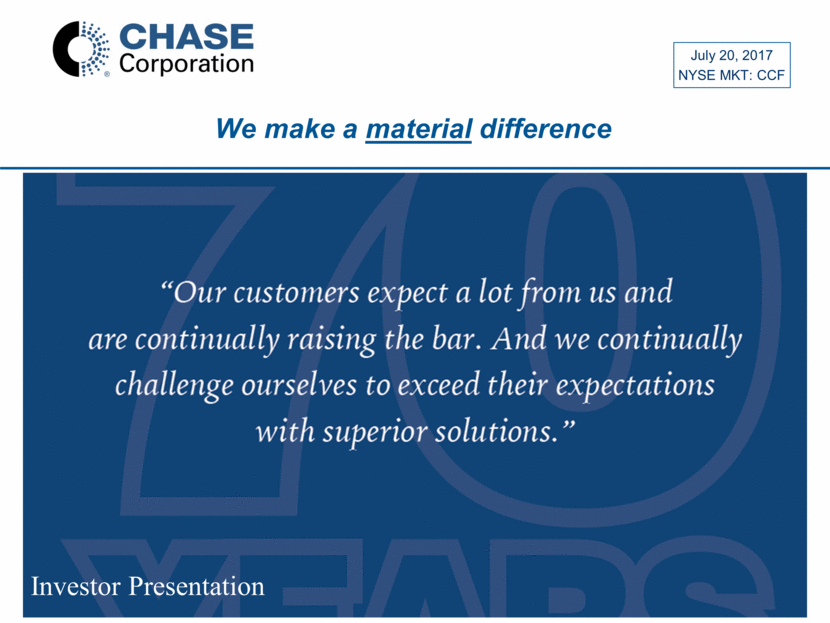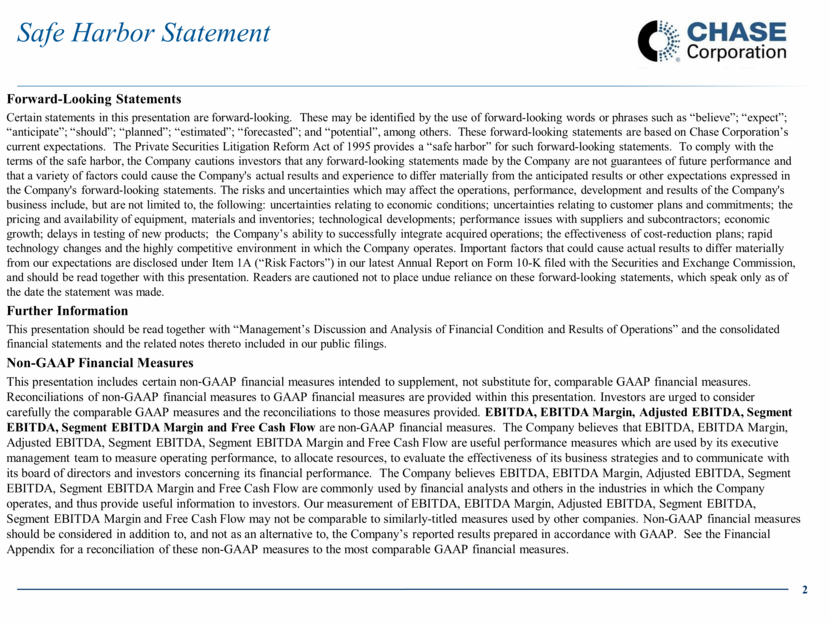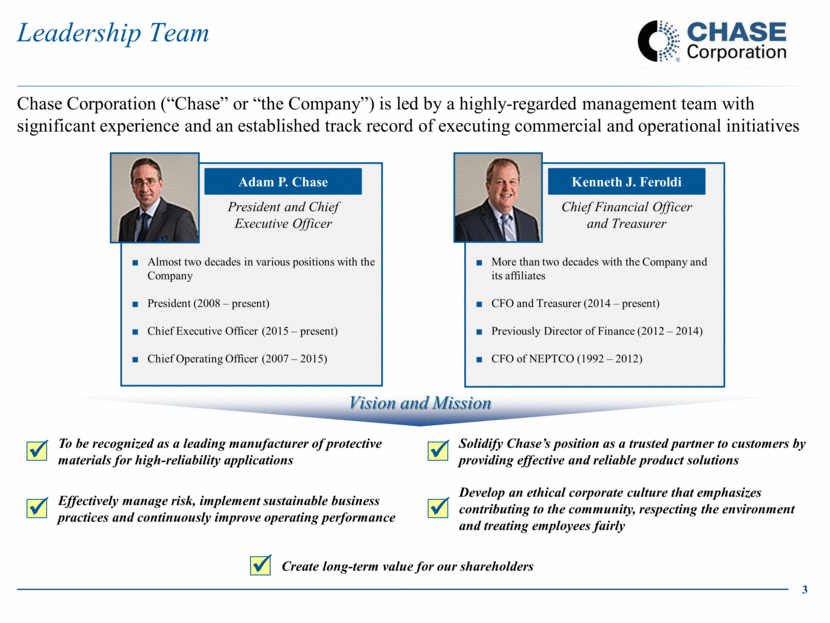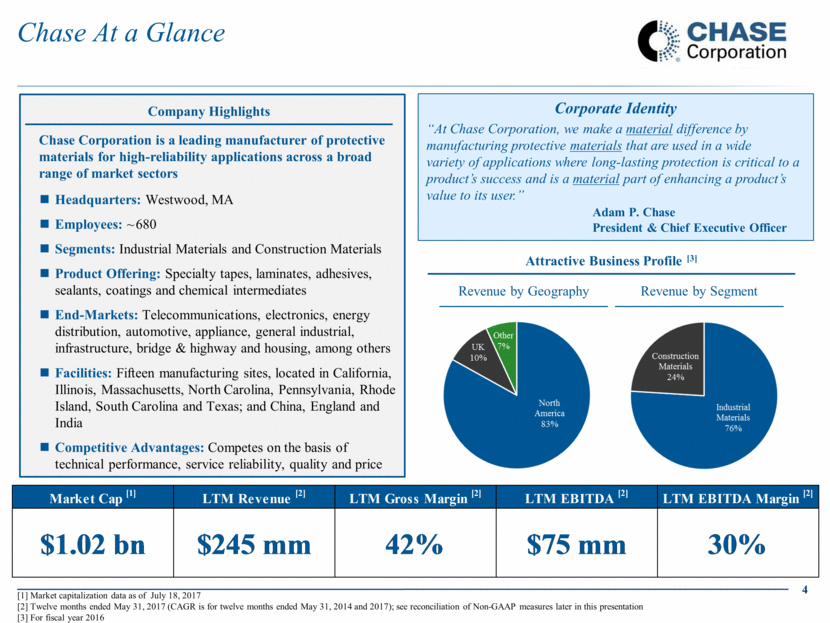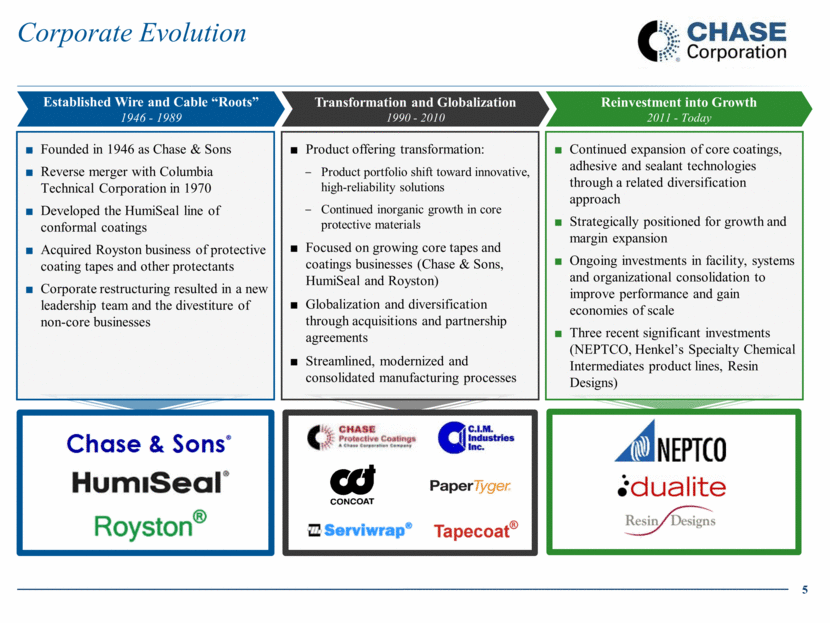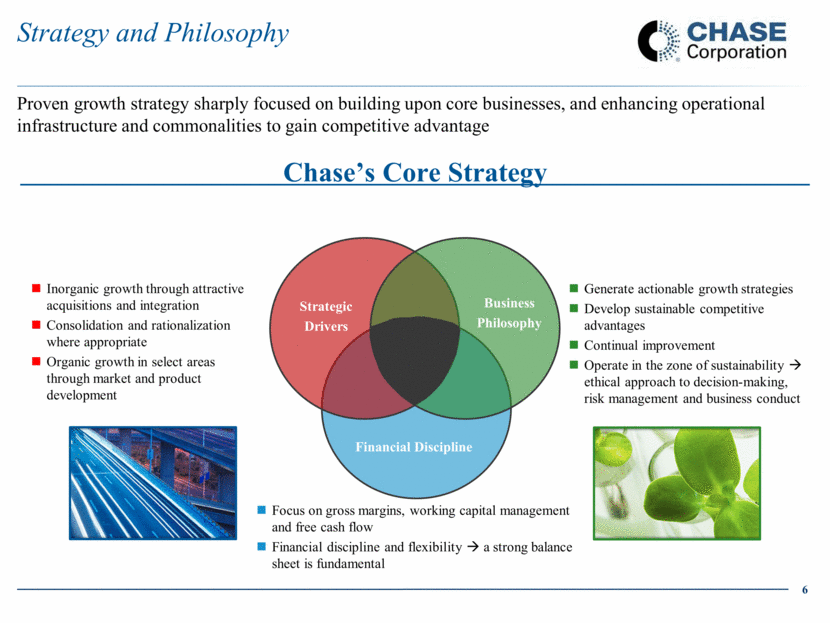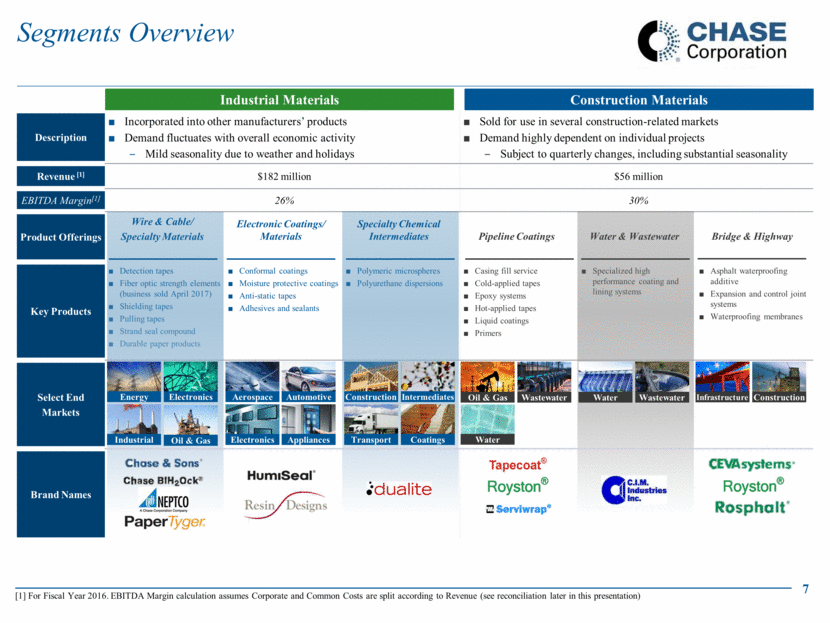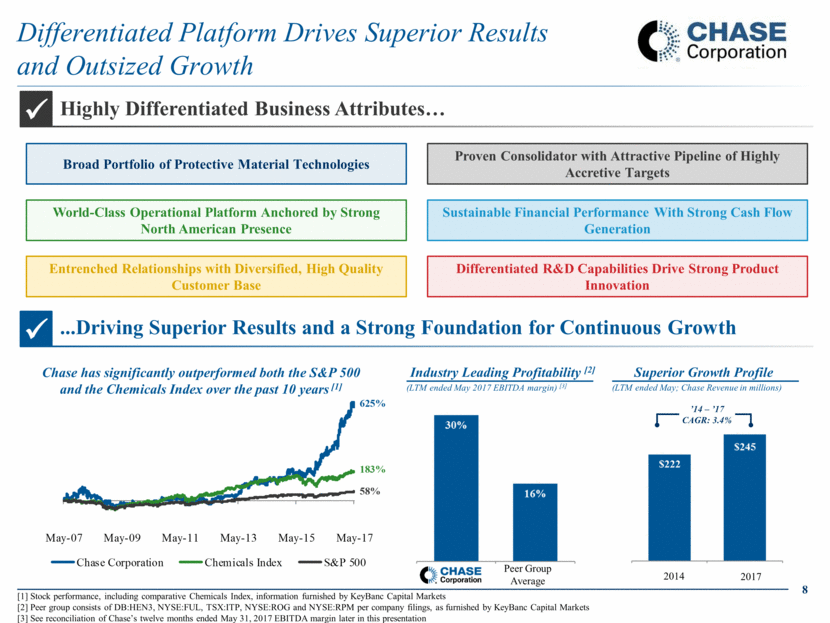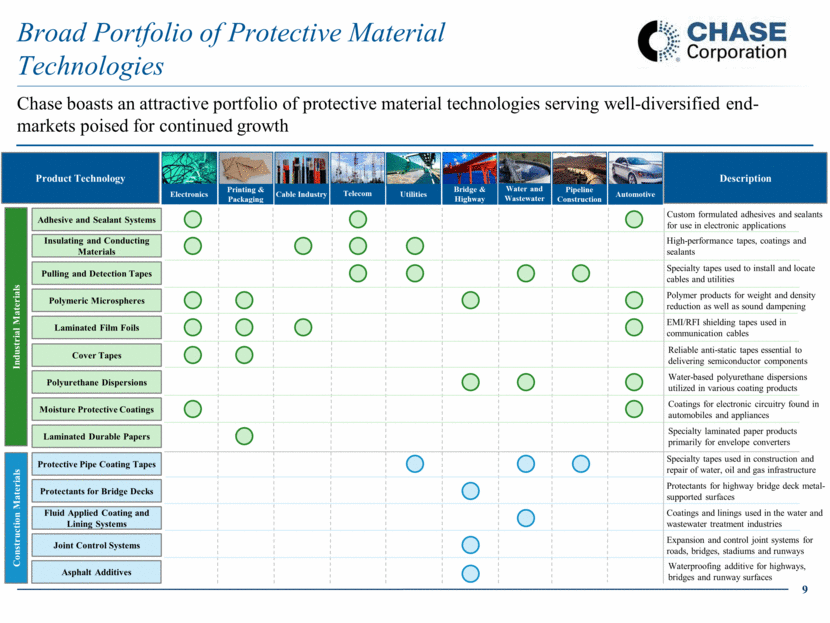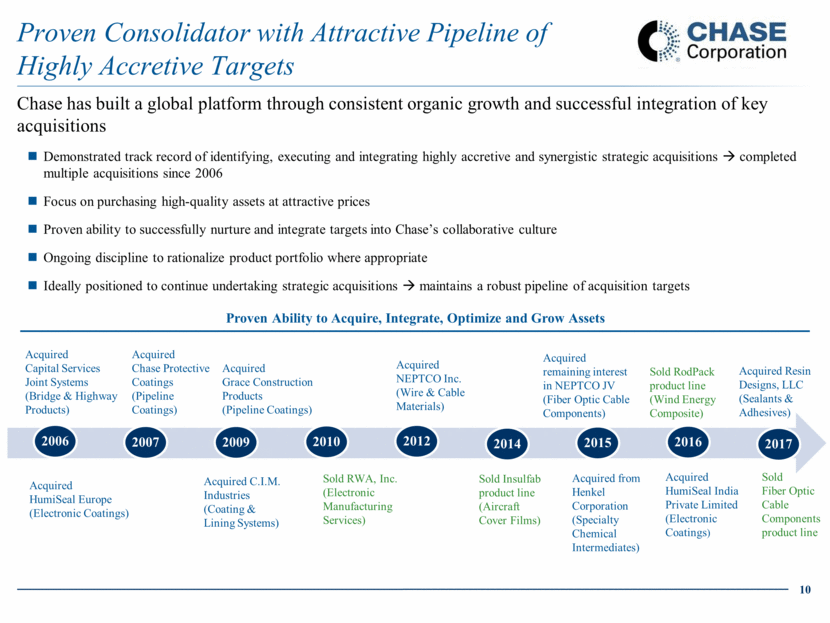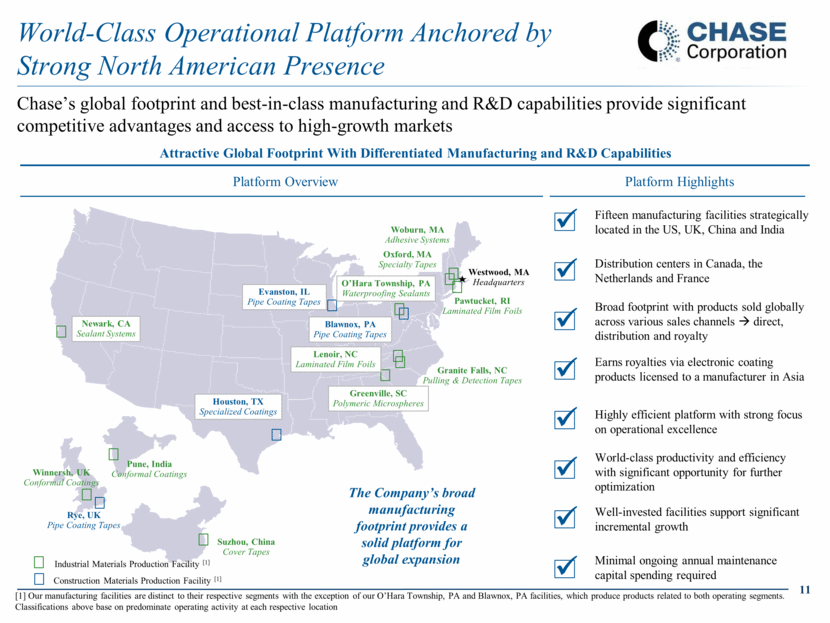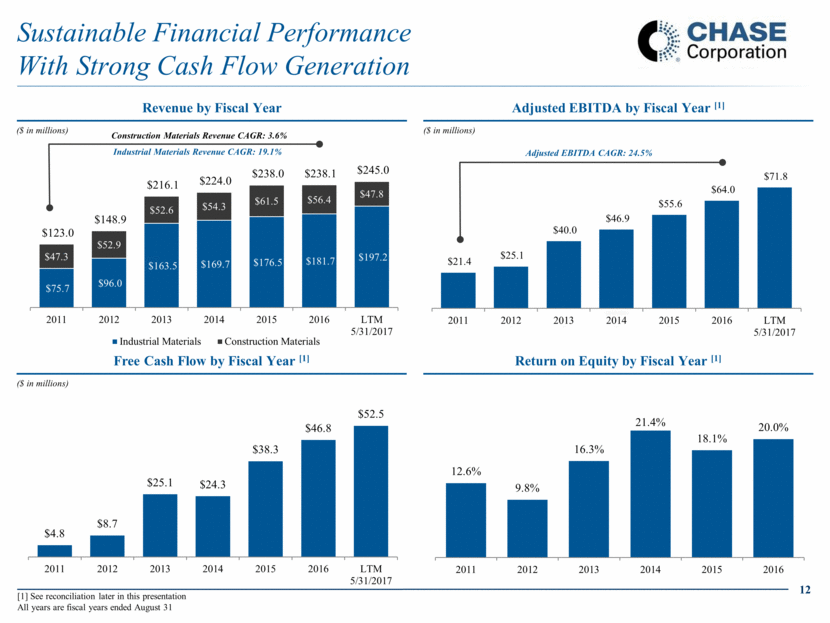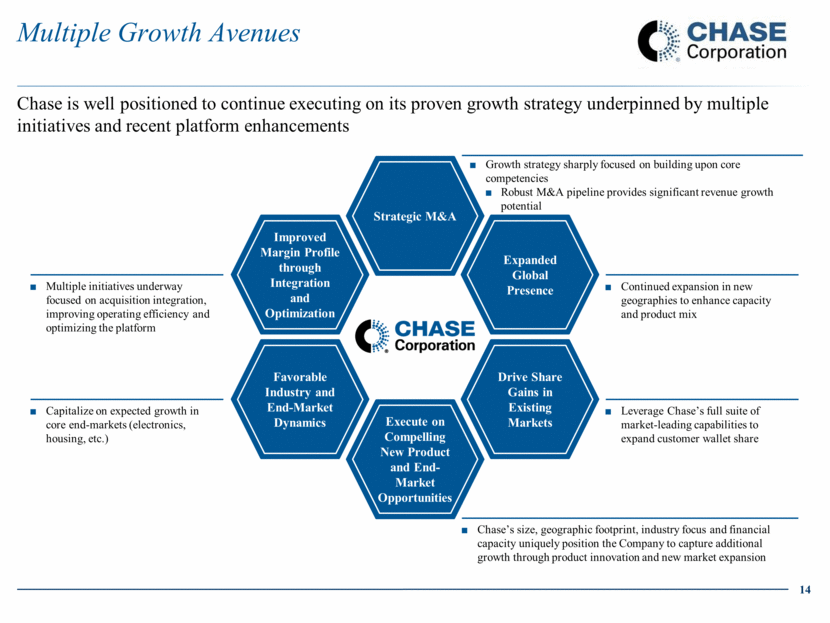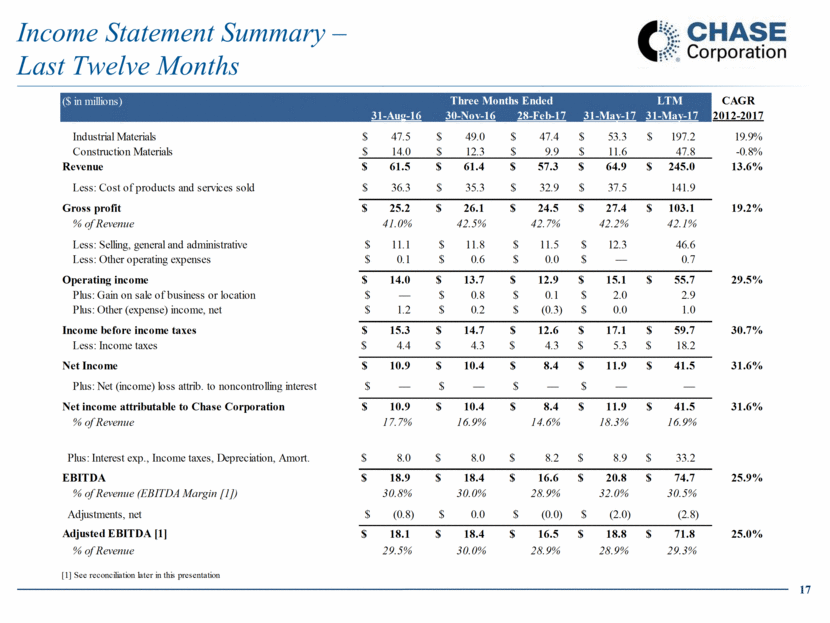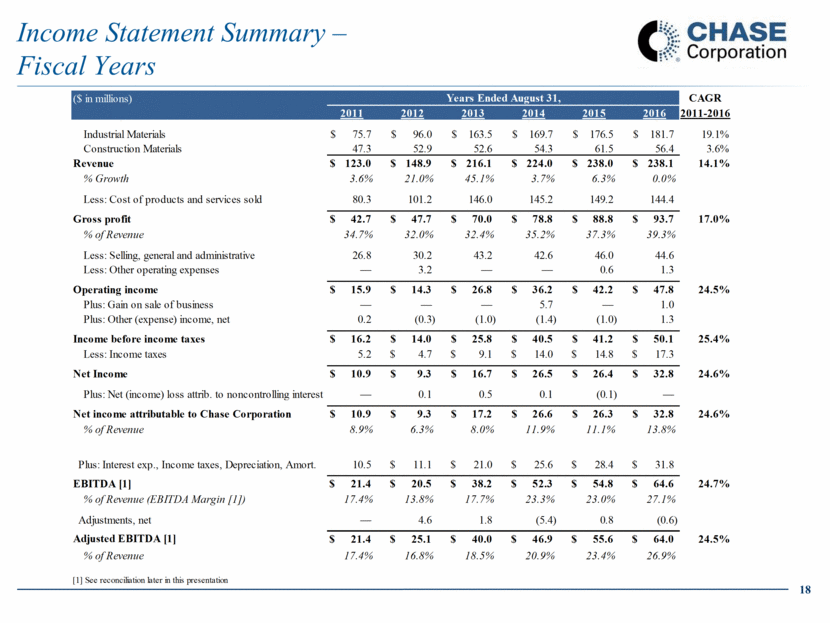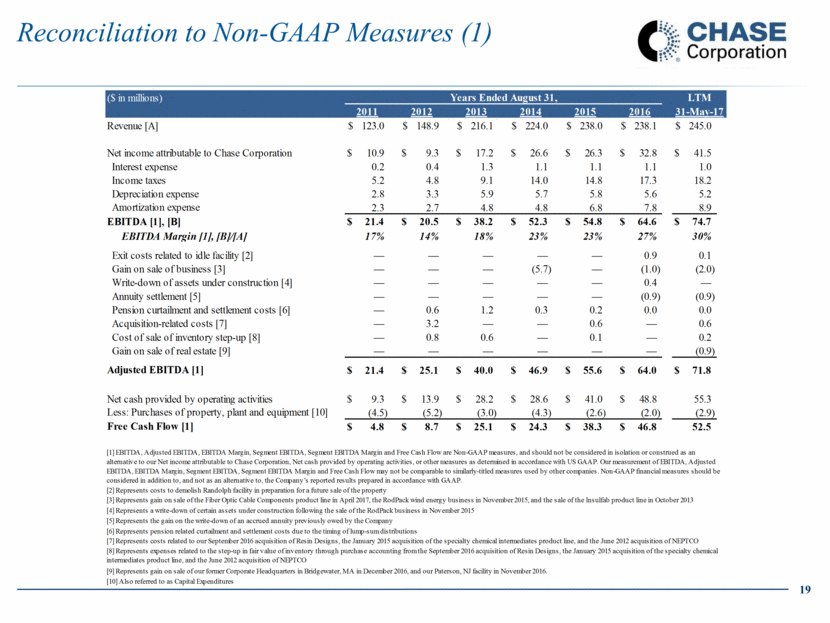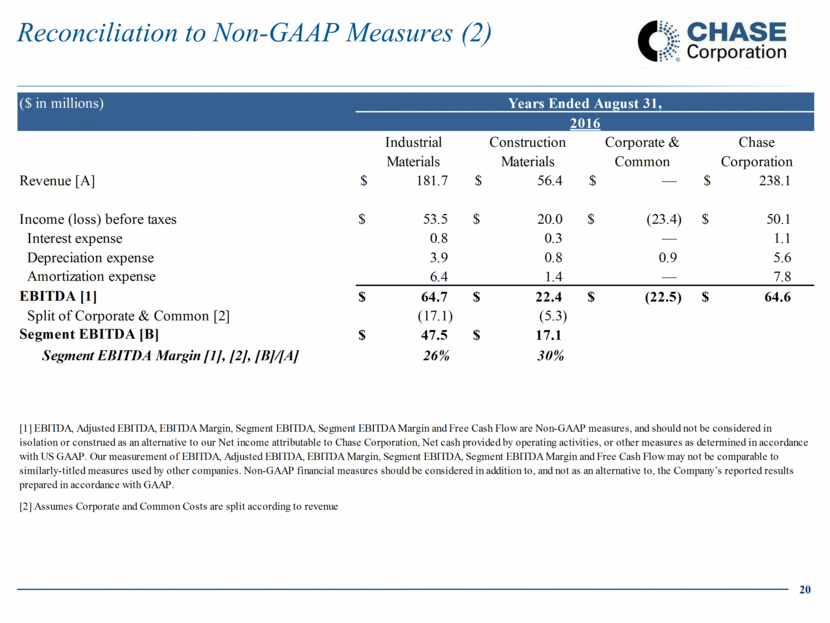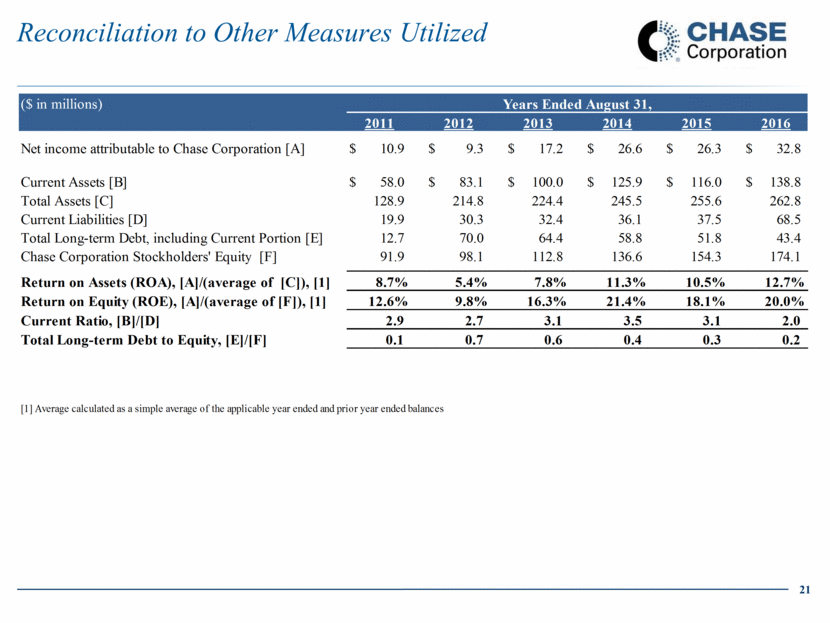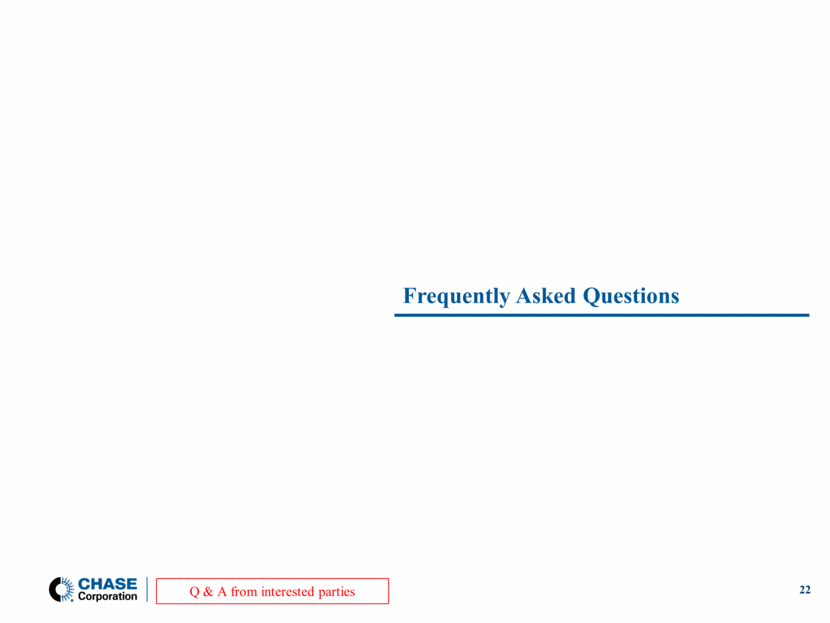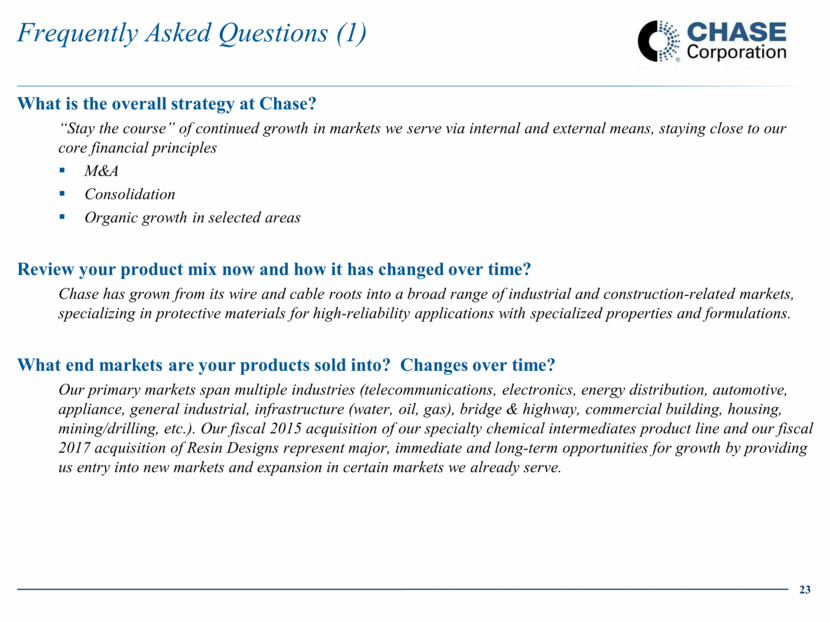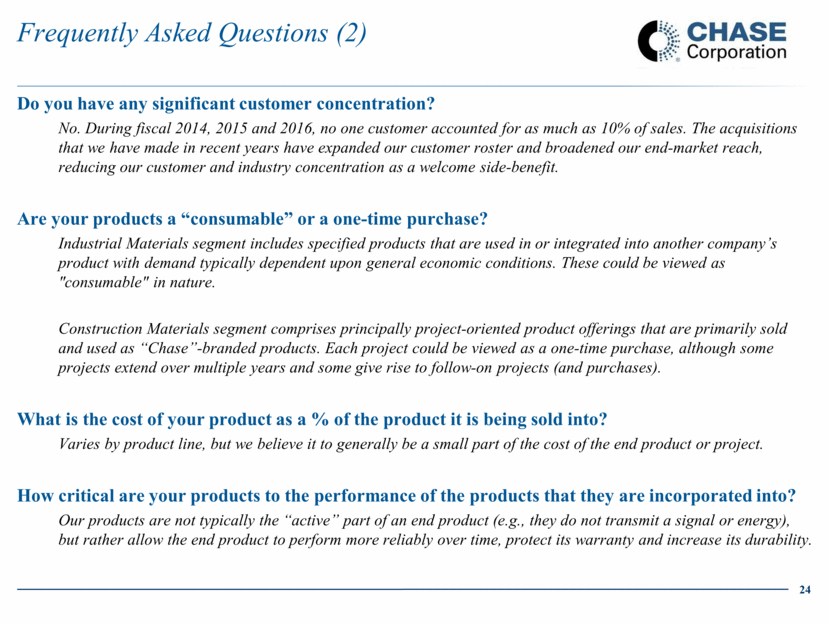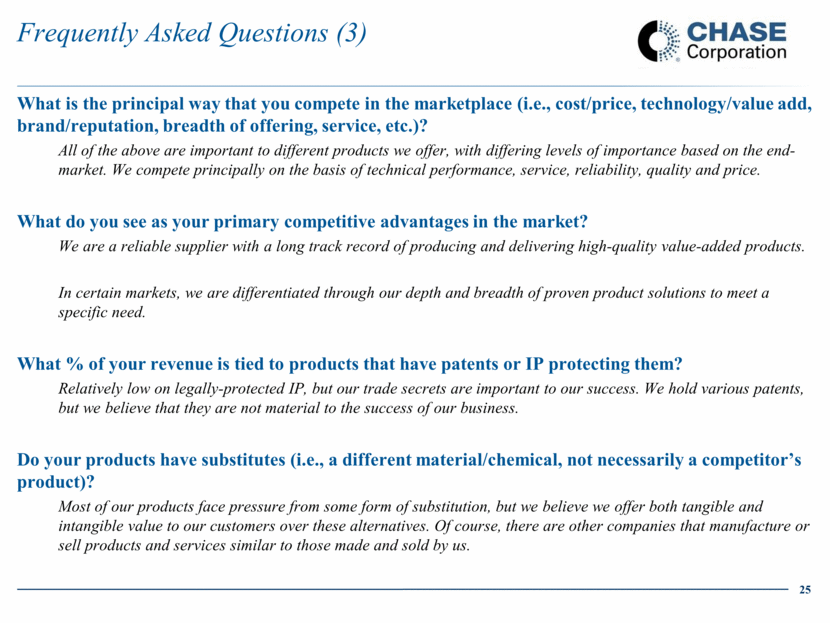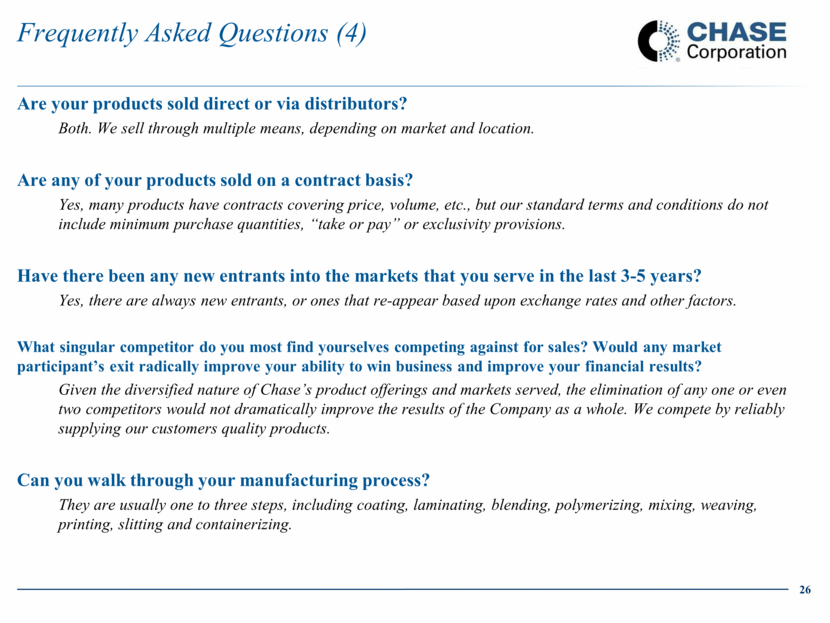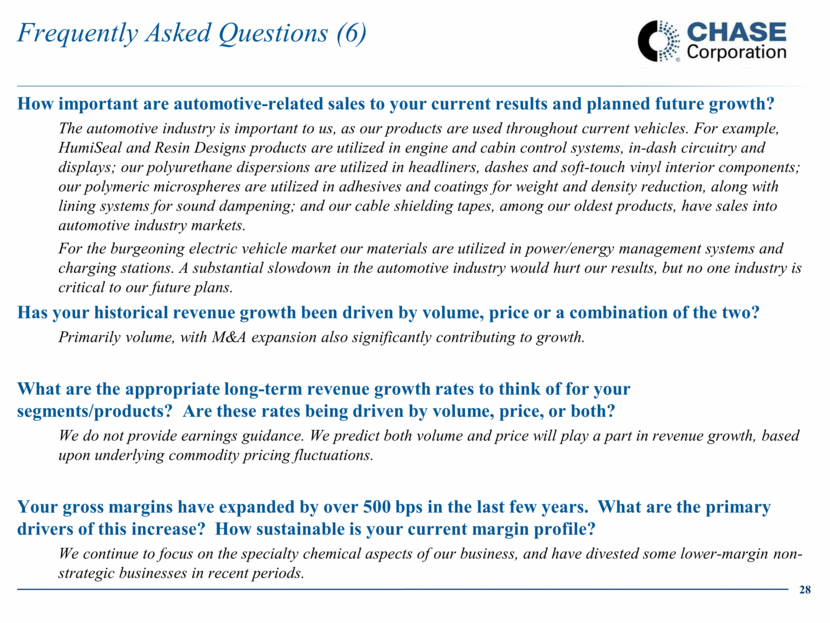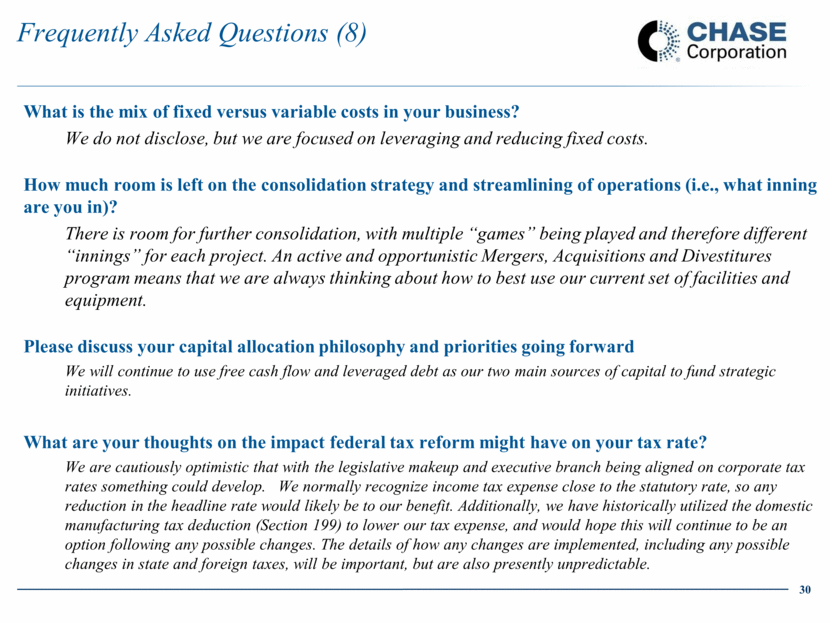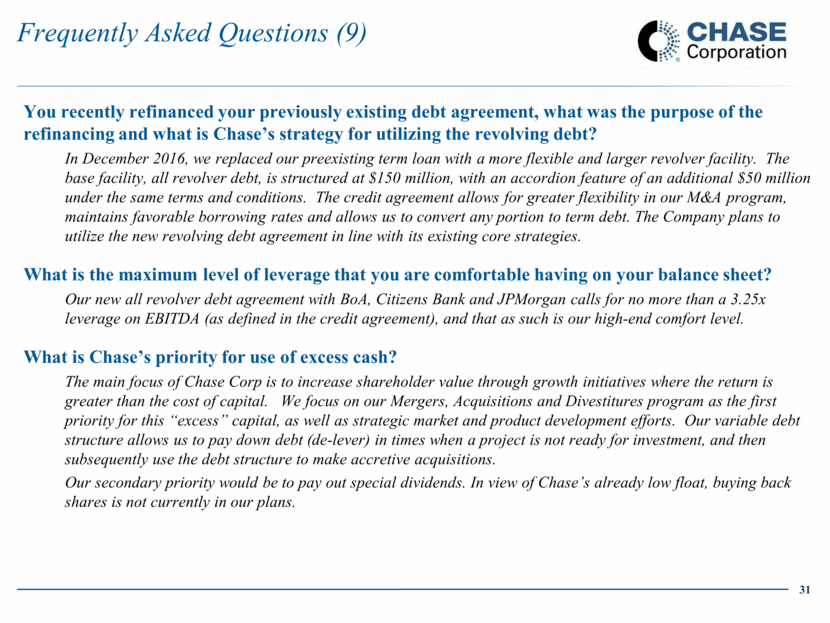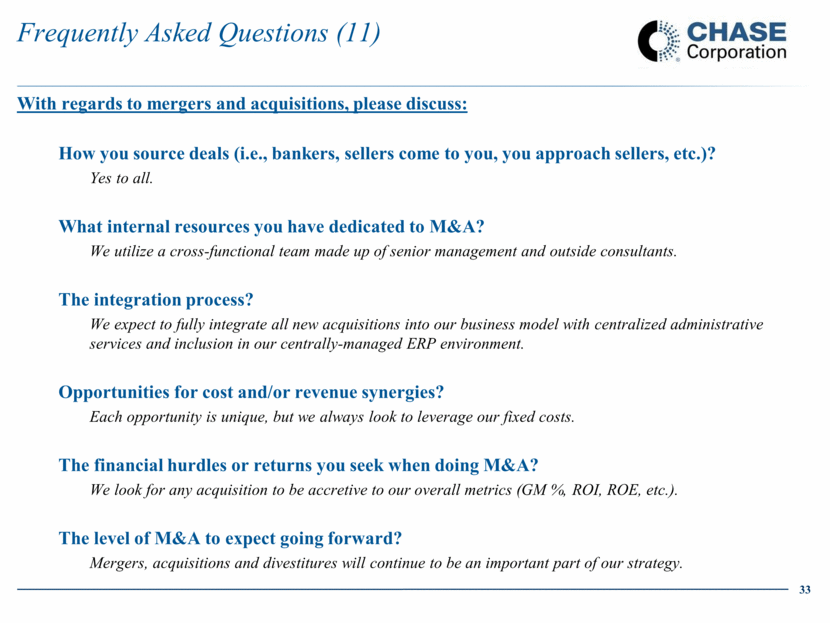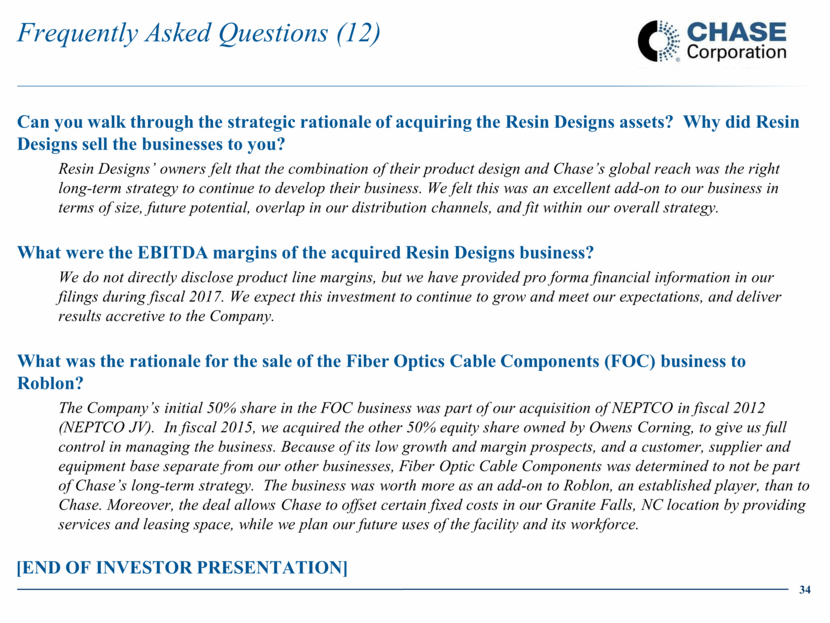Attached files
| file | filename |
|---|---|
| 8-K - 8-K - CHASE CORP | f8-k.htm |
Exhibit 99.1
|
|
We make a material difference Investor Presentation July 20, 2017 NYSE MKT: CCF |
|
|
Forward-Looking Statements Certain statements in this presentation are forward-looking. These may be identified by the use of forward-looking words or phrases such as “believe”; “expect”; “anticipate”; “should”; “planned”; “estimated”; “forecasted”; and “potential”, among others. These forward-looking statements are based on Chase Corporation’s current expectations. The Private Securities Litigation Reform Act of 1995 provides a “safe harbor” for such forward-looking statements. To comply with the terms of the safe harbor, the Company cautions investors that any forward-looking statements made by the Company are not guarantees of future performance and that a variety of factors could cause the Company's actual results and experience to differ materially from the anticipated results or other expectations expressed in the Company's forward-looking statements. The risks and uncertainties which may affect the operations, performance, development and results of the Company's business include, but are not limited to, the following: uncertainties relating to economic conditions; uncertainties relating to customer plans and commitments; the pricing and availability of equipment, materials and inventories; technological developments; performance issues with suppliers and subcontractors; economic growth; delays in testing of new products; the Company’s ability to successfully integrate acquired operations; the effectiveness of cost-reduction plans; rapid technology changes and the highly competitive environment in which the Company operates. Important factors that could cause actual results to differ materially from our expectations are disclosed under Item 1A (“Risk Factors”) in our latest Annual Report on Form 10-K filed with the Securities and Exchange Commission, and should be read together with this presentation. Readers are cautioned not to place undue reliance on these forward-looking statements, which speak only as of the date the statement was made. Further Information This presentation should be read together with “Management’s Discussion and Analysis of Financial Condition and Results of Operations” and the consolidated financial statements and the related notes thereto included in our public filings. Non-GAAP Financial Measures This presentation includes certain non‐GAAP financial measures intended to supplement, not substitute for, comparable GAAP financial measures. Reconciliations of non‐GAAP financial measures to GAAP financial measures are provided within this presentation. Investors are urged to consider carefully the comparable GAAP measures and the reconciliations to those measures provided. EBITDA, EBITDA Margin, Adjusted EBITDA, Segment EBITDA, Segment EBITDA Margin and Free Cash Flow are non-GAAP financial measures. The Company believes that EBITDA, EBITDA Margin, Adjusted EBITDA, Segment EBITDA, Segment EBITDA Margin and Free Cash Flow are useful performance measures which are used by its executive management team to measure operating performance, to allocate resources, to evaluate the effectiveness of its business strategies and to communicate with its board of directors and investors concerning its financial performance. The Company believes EBITDA, EBITDA Margin, Adjusted EBITDA, Segment EBITDA, Segment EBITDA Margin and Free Cash Flow are commonly used by financial analysts and others in the industries in which the Company operates, and thus provide useful information to investors. Our measurement of EBITDA, EBITDA Margin, Adjusted EBITDA, Segment EBITDA, Segment EBITDA Margin and Free Cash Flow may not be comparable to similarly-titled measures used by other companies. Non-GAAP financial measures should be considered in addition to, and not as an alternative to, the Company’s reported results prepared in accordance with GAAP. See the Financial Appendix for a reconciliation of these non-GAAP measures to the most comparable GAAP financial measures. Safe Harbor Statement |
|
|
More than two decades with the Company and its affiliates CFO and Treasurer (2014 – present) Previously Director of Finance (2012 – 2014) CFO of NEPTCO (1992 – 2012) Kenneth J. Feroldi Chief Financial Officer and Treasurer Almost two decades in various positions with the Company President (2008 – present) Chief Executive Officer (2015 – present) Chief Operating Officer (2007 – 2015) Adam P. Chase President and Chief Executive Officer Chase Corporation (“Chase” or “the Company”) is led by a highly-regarded management team with significant experience and an established track record of executing commercial and operational initiatives Leadership Team To be recognized as a leading manufacturer of protective materials for high-reliability applications Solidify Chase’s position as a trusted partner to customers by providing effective and reliable product solutions Create long-term value for our shareholders Effectively manage risk, implement sustainable business practices and continuously improve operating performance Develop an ethical corporate culture that emphasizes contributing to the community, respecting the environment and treating employees fairly Vision and Mission |
|
|
Chase At a Glance [1] Market capitalization data as of July 18, 2017 [2] Twelve months ended May 31, 2017 (CAGR is for twelve months ended May 31, 2014 and 2017); see reconciliation of Non-GAAP measures later in this presentation [3] For fiscal year 2016 Chase Corporation is a leading manufacturer of protective materials for high-reliability applications across a broad range of market sectors Headquarters: Westwood, MA Employees: ~ 680 Segments: Industrial Materials and Construction Materials Product Offering: Specialty tapes, laminates, adhesives, sealants, coatings and chemical intermediates End-Markets: Telecommunications, electronics, energy distribution, automotive, appliance, general industrial, infrastructure, bridge & highway and housing, among others Facilities: Fifteen manufacturing sites, located in California, Illinois, Massachusetts, North Carolina, Pennsylvania, Rhode Island, South Carolina and Texas; and China, England and India Competitive Advantages: Competes on the basis of technical performance, service reliability, quality and price Company Highlights Attractive Business Profile [3] Revenue by Geography Revenue by Segment Corporate Identity “At Chase Corporation, we make a material difference by manufacturing protective materials that are used in a wide variety of applications where long-lasting protection is critical to a product’s success and is a material part of enhancing a product’s value to its user.” Adam P. Chase President & Chief Executive Officer Market Cap [1] LTM Revenue [2] LTM Gross Margin [2] LTM EBITDA [2] LTM EBITDA Margin [2] $1.02 bn $245 mm 42% $75 mm 30% |
|
|
Established Wire and Cable “Roots” 1946 - 1989 Continued expansion of core coatings, adhesive and sealant technologies through a related diversification approach Strategically positioned for growth and margin expansion Ongoing investments in facility, systems and organizational consolidation to improve performance and gain economies of scale Three recent significant investments (NEPTCO, Henkel’s Specialty Chemical Intermediates product lines, Resin Designs) Product offering transformation: Product portfolio shift toward innovative, high-reliability solutions Continued inorganic growth in core protective materials Focused on growing core tapes and coatings businesses (Chase & Sons, HumiSeal and Royston) Globalization and diversification through acquisitions and partnership agreements Streamlined, modernized and consolidated manufacturing processes Founded in 1946 as Chase & Sons Reverse merger with Columbia Technical Corporation in 1970 Developed the HumiSeal line of conformal coatings Acquired Royston business of protective coating tapes and other protectants Corporate restructuring resulted in a new leadership team and the divestiture of non-core businesses Transformation and Globalization 1990 - 2010 Reinvestment into Growth 2011 - Today Corporate Evolution |
|
|
Strategy and Philosophy Inorganic growth through attractive acquisitions and integration Consolidation and rationalization where appropriate Organic growth in select areas through market and product development Generate actionable growth strategies Develop sustainable competitive advantages Continual improvement Operate in the zone of sustainability ethical approach to decision-making, risk management and business conduct Focus on gross margins, working capital management and free cash flow Financial discipline and flexibility a strong balance sheet is fundamental Financial Discipline Strategic Drivers Business Philosophy Chase’s Core Strategy Proven growth strategy sharply focused on building upon core businesses, and enhancing operational infrastructure and commonalities to gain competitive advantage |
|
|
Description Incorporated into other manufacturers’ products Demand fluctuates with overall economic activity Mild seasonality due to weather and holidays Sold for use in several construction-related markets Demand highly dependent on individual projects Subject to quarterly changes, including substantial seasonality Revenue [1] $182 million $56 million EBITDA Margin[1] 26% 30% Product Offerings Wire & Cable/ Specialty Materials Electronic Coatings/ Materials Specialty Chemical Intermediates Pipeline Coatings Water & Wastewater Bridge & Highway Key Products Detection tapes Fiber optic strength elements (business sold April 2017) Shielding tapes Pulling tapes Strand seal compound Durable paper products Conformal coatings Moisture protective coatings Anti-static tapes Adhesives and sealants Polymeric microspheres Polyurethane dispersions Casing fill service Cold-applied tapes Epoxy systems Hot-applied tapes Liquid coatings Primers Specialized high performance coating and lining systems Asphalt waterproofing additive Expansion and control joint systems Waterproofing membranes Select End Markets Brand Names Segment Manufacturing ocations Blawnox, PA Granite Falls, NC Greenville, SC Lenoir, NC Newark, CA O’Hara Township, PA Oxford, MA Pawtucket, RI Woburn, MA Pune, India Suzhou, China Winnersh, England Blawnox, PA Evanston, IL Houston, TX O’Hara Township, PA Rye, England Construction Materials [1] For Fiscal Year 2016. EBITDA Margin calculation assumes Corporate and Common Costs are split according to Revenue (see reconciliation later in this presentation) Segments Overview Industrial Materials Energy Electronics Oil & Gas Industrial Aerospace Automotive Electronics Appliances Construction Intermediates Transport Coatings Oil & Gas Wastewater Water Wastewater Infrastructure Construction Water 7 |
|
|
Peer Group Average ’14 – ’17 CAGR: 3.4% [1] Stock performance, including comparative Chemicals Index, information furnished by KeyBanc Capital Markets [2] Peer group consists of DB:HEN3, NYSE:FUL, TSX:ITP, NYSE:ROG and NYSE:RPM per company filings, as furnished by KeyBanc Capital Markets [3] See reconciliation of Chase’s twelve months ended May 31, 2017 EBITDA margin later in this presentation Differentiated Platform Drives Superior Results and Outsized Growth ü Highly Differentiated Business Attributes ü ...Driving Superior Results and a Strong Foundation for Continuous Growth Broad Portfolio of Protective Material Technologies Proven Consolidator with Attractive Pipeline of Highly Accretive Targets World-Class Operational Platform Anchored by Strong North American Presence Sustainable Financial Performance With Strong Cash Flow Generation Entrenched Relationships with Diversified, High Quality Customer Base Differentiated R&D Capabilities Drive Strong Product Innovation Chase has significantly outperformed both the S&P 500 and the Chemicals Index over the past 10 years [1] (LTM ended May 2017 EBITDA margin) [3] Industry Leading Profitability [2] (LTM ended May; Chase Revenue in millions) Superior Growth Profile 2014 2017 May-07 May-09 May-11 May-13 May-15 May-17 Chase Corporation Chemicals Index S&P 500 625 % 183 % 5 8% |
|
|
Chase boasts an attractive portfolio of protective material technologies serving well-diversified end- markets poised for continued growth Broad Portfolio of Protective Material Technologies Industrial Materials Description Product Technology Construction Materials Insulating and Conducting Materials Cover Tapes Protective Pipe Coating Tapes Protectants for Bridge Decks Fluid Applied Coating and Lining Systems Joint Control Systems Moisture Protective Coatings Laminated Film Foils Laminated Durable Papers Pulling and Detection Tapes Polyurethane Dispersions Polymeric Microspheres High-performance tapes, coatings and sealants Specialty tapes used to install and locate cables and utilities Polymer products for weight and density reduction as well as sound dampening EMI/RFI shielding tapes used in communication cables Reliable anti-static tapes essential to delivering semiconductor components Water-based polyurethane dispersions utilized in various coating products Coatings for electronic circuitry found in automobiles and appliances Specialty laminated paper products primarily for envelope converters Specialty tapes used in construction and repair of water, oil and gas infrastructure Protectants for highway bridge deck metal-supported surfaces Coatings and linings used in the water and wastewater treatment industries Expansion and control joint systems for roads, bridges, stadiums and runways Water and Wastewater Cable Industry Bridge & Highway Pipeline Construction Telecom Utilities Printing & Packaging Telecom Electronics Automotive Adhesive and Sealant Systems Custom formulated adhesives and sealants for use in electronic applications Asphalt Additives Waterproofing additive for highways, bridges and runway surfaces |
|
|
Sold RodPack product line (Wind Energy Composite) Acquired Capital Services Joint Systems (Bridge & Highway Products) Acquired Chase Protective Coatings (Pipeline Coatings) Acquired Grace Construction Products (Pipeline Coatings) Acquired NEPTCO Inc. (Wire & Cable Materials) 2006 2007 2009 2010 2012 2014 2016 2015 Chase has built a global platform through consistent organic growth and successful integration of key acquisitions Demonstrated track record of identifying, executing and integrating highly accretive and synergistic strategic acquisitions completed multiple acquisitions since 2006 Focus on purchasing high-quality assets at attractive prices Proven ability to successfully nurture and integrate targets into Chase’s collaborative culture Ongoing discipline to rationalize product portfolio where appropriate Ideally positioned to continue undertaking strategic acquisitions maintains a robust pipeline of acquisition targets Proven Consolidator with Attractive Pipeline of Highly Accretive Targets Proven Ability to Acquire, Integrate, Optimize and Grow Assets Acquired HumiSeal Europe (Electronic Coatings) Acquired C.I.M. Industries (Coating & Lining Systems) Sold RWA, Inc. (Electronic Manufacturing Services) Sold Insulfab product line (Aircraft Cover Films) Acquired from Henkel Corporation (Specialty Chemical Intermediates) Acquired remaining interest in NEPTCO JV (Fiber Optic Cable Components) Acquired HumiSeal India Private Limited (Electronic Coatings) 2017 Acquired Resin Designs, LLC (Sealants & Adhesives) Sold Fiber Optic Cable Components product line |
|
|
Chase’s global footprint and best-in-class manufacturing and R&D capabilities provide significant competitive advantages and access to high-growth markets World-Class Operational Platform Anchored by Strong North American Presence Attractive Global Footprint With Differentiated Manufacturing and R&D Capabilities Platform Overview Platform Highlights Winnersh, UK Conformal Coatings Rye, UK Pipe Coating Tapes Suzhou, China Cover Tapes Construction Materials Production Facility [1] ü Fifteen manufacturing facilities strategically located in the US, UK, China and India ü Broad footprint with products sold globally across various sales channels direct, distribution and royalty ü Highly efficient platform with strong focus on operational excellence ü Well-invested facilities support significant incremental growth ü World-class productivity and efficiency with significant opportunity for further optimization ü Minimal ongoing annual maintenance capital spending required Houston, TX Specialized Coatings Evanston, IL Pipe Coating Tapes O’Hara Township, PA Waterproofing Sealants Blawnox, PA Pipe Coating Tapes Greenville, SC Polymeric Microspheres Lenoir, NC Laminated Film Foils Granite Falls, NC Pulling & Detection Tapes Oxford, MA Specialty Tapes Westwood, MA Headquarters Pawtucket, RI Laminated Film Foils ü Distribution centers in Canada, the Netherlands and France ü Earns royalties via electronic coating products licensed to a manufacturer in Asia The Company’s broad manufacturing footprint provides a solid platform for global expansion Pune, India Conformal Coatings Woburn, MA Adhesive Systems Newark, CA Sealant Systems Industrial Materials Production Facility [1] [1] Our manufacturing facilities are distinct to their respective segments with the exception of our O’Hara Township, PA and Blawnox, PA facilities, which produce products related to both operating segments. Classifications above base on predominate operating activity at each respective location |
|
|
Sustainable Financial Performance With Strong Cash Flow Generation [1] See reconciliation later in this presentation All years are fiscal years ended August 31 Adjusted EBITDA by Fiscal Year [1] Revenue by Fiscal Year ($ in millions) Free Cash Flow by Fiscal Year [1] ($ in millions) Return on Equity by Fiscal Year [1] ($ in millions) Construction Materials Revenue CAGR: 3.6% Industrial Materials Revenue CAGR: 19.1% Adjusted EBITDA CAGR: 24.5% $4.8 $8.7 $25.1 $24.3 $38.3 $46.8 $52.5 2011 2012 2013 2014 2015 2016 LTM 5/31/2017 $75.7 $96.0 $163.5 $169.7 $176.5 $181.7 $197.2 $47.3 $52.9 $52.6 $54.3 $61.5 $56.4 $47.8 $123.0 $148.9 $216.1 $224.0 $238.0 $238.1 $245.0 2011 2012 2013 2014 2015 2016 LTM 5/31/2017 Industrial Materials Construction Materials $21.4 $25.1 $40.0 $46.9 $55.6 $64.0 $71.8 2011 2012 2013 2014 2015 2016 LTM 5/31/2017 12.6% 9.8% 16.3% 21.4% 18.1% 20.0% 2011 2012 2013 2014 2015 2016 |
|
|
Income Reinvested Into Business, Coupled With a Return to Shareholders [1] Net income attributable to Chase Corporation All years are fiscal years ended August 31 Net Income by Fiscal Year [1] ($ in millions) Earnings Per Diluted Share by Fiscal Year ($ per share) Cash Dividends Per Share by Fiscal Year Paid $3.7mm 2014, $0.7mm in 2016 and $1.4mm in LTM May 31, 2017 were gains from the sales of businesses $0.40 in 2014, $0.07 in 2016 and $0.14 in LTM May 31, 2017 were gains from the sales of businesses $0.10 in 2015 was a special dividend for gain from the sale of a business ($ per share) Dividends Paid as a % of Prior Year Net Income [1] $0.35 $0.35 $0.40 $0.45 $0.60 $0.65 $0.70 2011 2012 2013 2014 2015 2016 LTM 5/31/2017 $1.22 $1.03 $1.87 $2.86 $2.82 $3.50 $4.40 2011 2012 2013 2014 2015 2016 LTM 5/31/2017 $10.9 $9.3 $17.2 $26.6 $26.3 $32.8 $41.5 2011 2012 2013 2014 2015 2016 LTM 5/31/2017 25% 29% 39% 24% 21% 23% 2011 2012 2013 2014 2015 2016 |
|
|
Expanded Global Presence Chase is well positioned to continue executing on its proven growth strategy underpinned by multiple initiatives and recent platform enhancements Multiple Growth Avenues Strategic M&A Drive Share Gains in Existing Markets Execute on Compelling New Product and End- Market Opportunities Favorable Industry and End-Market Dynamics Improved Margin Profile through Integration and Optimization Growth strategy sharply focused on building upon core competencies Robust M&A pipeline provides significant revenue growth potential Multiple initiatives underway focused on acquisition integration, improving operating efficiency and optimizing the platform Continued expansion in new geographies to enhance capacity and product mix Capitalize on expected growth in core end-markets (electronics, housing, etc.) Leverage Chase’s full suite of market-leading capabilities to expand customer wallet share Chase’s size, geographic footprint, industry focus and financial capacity uniquely position the Company to capture additional growth through product innovation and new market expansion |
|
|
[1] See reconciliation later in this presentation All years are fiscal years ended August 31 Balance Sheet Supports an Acquisition Program ROE % and ROA % by Fiscal Year [1] Current Ratio at Fiscal Year End [1] Debt to Equity Ratio at Fiscal Year End [1] 0.1 0.7 0.6 0.4 0.3 0.2 2011 2012 2013 2014 2015 2016 All debt, long - term and current portions combined 12.6% 9.8% 16.3% 21.4% 18.1% 20.0% 8.7% 5.4% 7.8% 11.3% 10.5% 12.7% 2011 2012 2013 2014 2015 2016 ROE % ROA % 2.9 2.7 3.1 3.5 3.1 2.0 2011 2012 2013 2014 2015 2016 The 2016 current ratio includes all term debt as a current liability |
|
|
Financial Appendix For last twelve months ended May 31, 2017 and fiscal years ended August 31 |
|
|
Income Statement Summary – Last Twelve Months ($ in millions) LTM CAGR 2012-2017 Industrial Materials $ 47.5 $ 49.0 $ 47.4 $ 53.3 $ 197.2 19.9% Construction Materials $ 14.0 $ 12.3 $ 9.9 $ 11.6 47.8 -0.8% Revenue $ 61.5 $ 61.4 $ 57.3 $ 64.9 $ 245.0 13.6% Less: Cost of products and services sold $ 36.3 $ 35.3 $ 32.9 $ 37.5 141.9 Gross profit $ 25.2 $ 26.1 $ 24.5 $ 27.4 $ 103.1 19.2% % of Revenue 41.0% 42.5% 42.7% 42.2% 42.1% Less: Selling, general and administrative $ 11.1 $ 11.8 $ 11.5 $ 12.3 46.6 Less: Other operating expenses $ 0.1 $ 0.6 $ 0.0 $ — 0.7 Operating income $ 14.0 $ 13.7 $ 12.9 $ 15.1 $ 55.7 29.5% Plus: Gain on sale of business or location $ — $ 0.8 $ 0.1 $ 2.0 2.9 Plus: Other (expense) income, net $ 1.2 $ 0.2 $ (0.3) $ 0.0 1.0 Income before income taxes $ 15.3 $ 14.7 $ 12.6 $ 17.1 $ 59.7 30.7% Less: Income taxes $ 4.4 $ 4.3 $ 4.3 $ 5.3 $ 18.2 Net Income $ 10.9 $ 10.4 $ 8.4 $ 11.9 $ 41.5 31.6% Plus: Net (income) loss attrib. to noncontrolling interest $ — $ — $ — $ — — Net income attributable to Chase Corporation $ 10.9 $ 10.4 $ 8.4 $ 11.9 $ 41.5 31.6% % of Revenue 17.7% 16.9% 14.6% 18.3% 16.9% Plus: Interest exp., Income taxes, Depreciation, Amort. $ 8.0 $ 8.0 $ 8.2 $ 8.9 $ 33.2 EBITDA $ 18.9 $ 18.4 $ 16.6 $ 20.8 $ 74.7 25.9% % of Revenue (EBITDA Margin [1]) 30.8% 30.0% 28.9% 32.0% 30.5% Adjustments, net $ (0.8) $ 0.0 $ (0.0) $ (2.0) (2.8) Adjusted EBITDA [1] $ 18.1 $ 18.4 $ 16.5 $ 18.8 $ 71.8 25.0% % of Revenue 29.5% 30.0% 28.9% 28.9% 29.3% [1] See reconciliation later in this presentation 31-May-17 28-Feb-17 Three Months Ended 31-May-17 31-Aug-16 30-Nov-16 |
|
|
Income Statement Summary – Fiscal Years ($ in millions) CAGR 2011-2016 Industrial Materials $ 75.7 $ 96.0 $ 163.5 $ 169.7 $ 176.5 $ 181.7 19.1% Construction Materials 47.3 52.9 52.6 54.3 61.5 56.4 3.6% Revenue $ 123.0 $ 148.9 $ 216.1 $ 224.0 $ 238.0 $ 238.1 14.1% % Growth 3.6% 21.0% 45.1% 3.7% 6.3% 0.0% Less: Cost of products and services sold 80.3 101.2 146.0 145.2 149.2 144.4 Gross profit $ 42.7 $ 47.7 $ 70.0 $ 78.8 $ 88.8 $ 93.7 17.0% % of Revenue 34.7% 32.0% 32.4% 35.2% 37.3% 39.3% Less: Selling, general and administrative 26.8 30.2 43.2 42.6 46.0 44.6 Less: Other operating expenses — 3.2 — — 0.6 1.3 Operating income $ 15.9 $ 14.3 $ 26.8 $ 36.2 $ 42.2 $ 47.8 24.5% Plus: Gain on sale of business — — — 5.7 — 1.0 Plus: Other (expense) income, net 0.2 (0.3) (1.0) (1.4) (1.0) 1.3 Income before income taxes $ 16.2 $ 14.0 $ 25.8 $ 40.5 $ 41.2 $ 50.1 25.4% Less: Income taxes 5.2 $ 4.7 $ 9.1 $ 14.0 $ 14.8 $ 17.3 Net Income $ 10.9 $ 9.3 $ 16.7 $ 26.5 $ 26.4 $ 32.8 24.6% Plus: Net (income) loss attrib. to noncontrolling interest — 0.1 0.5 0.1 (0.1) — Net income attributable to Chase Corporation $ 10.9 $ 9.3 $ 17.2 $ 26.6 $ 26.3 $ 32.8 24.6% % of Revenue 8.9% 6.3% 8.0% 11.9% 11.1% 13.8% Plus: Interest exp., Income taxes, Depreciation, Amort. 10.5 $ 11.1 $ 21.0 $ 25.6 $ 28.4 $ 31.8 EBITDA [1] $ 21.4 $ 20.5 $ 38.2 $ 52.3 $ 54.8 $ 64.6 24.7% % of Revenue (EBITDA Margin [1]) 17.4% 13.8% 17.7% 23.3% 23.0% 27.1% Adjustments, net — 4.6 1.8 (5.4) 0.8 (0.6) Adjusted EBITDA [1] $ 21.4 $ 25.1 $ 40.0 $ 46.9 $ 55.6 $ 64.0 24.5% % of Revenue 17.4% 16.8% 18.5% 20.9% 23.4% 26.9% [1] See reconciliation later in this presentation 2016 Years Ended August 31, 2014 2015 2011 2012 2013 |
|
|
Reconciliation to Non-GAAP Measures (1) ($ in millions) LTM Revenue [A] $ 123.0 $ 148.9 $ 216.1 $ 224.0 $ 238.0 $ 238.1 $ 245.0 Net income attributable to Chase Corporation $ 10.9 $ 9.3 $ 17.2 $ 26.6 $ 26.3 $ 32.8 $ 41.5 Interest expense 0.2 0.4 1.3 1.1 1.1 1.1 1.0 Income taxes 5.2 4.8 9.1 14.0 14.8 17.3 18.2 Depreciation expense 2.8 3.3 5.9 5.7 5.8 5.6 5.2 Amortization expense 2.3 2.7 4.8 4.8 6.8 7.8 8.9 EBITDA [1], [B] $ 21.4 $ 20.5 $ 38.2 $ 52.3 $ 54.8 $ 64.6 $ 74.7 EBITDA Margin [1], [B]/[A] 17% 14% 18% 23% 23% 27% 30% Exit costs related to idle facility [2] — — — — — 0.9 0.1 Gain on sale of business [3] — — — (5.7) — (1.0) (2.0) Write-down of assets under construction [4] — — — — — 0.4 — Annuity settlement [5] — — — — — (0.9) (0.9) Pension curtailment and settlement costs [6] — 0.6 1.2 0.3 0.2 0.0 0.0 Acquisition-related costs [7] — 3.2 — — 0.6 — 0.6 Cost of sale of inventory step-up [8] — 0.8 0.6 — 0.1 — 0.2 Gain on sale of real estate [9] — — — — — — (0.9) Adjusted EBITDA [1] $ 21.4 $ 25.1 $ 40.0 $ 46.9 $ 55.6 $ 64.0 $ 71.8 Net cash provided by operating activities $ 9.3 $ 13.9 $ 28.2 $ 28.6 $ 41.0 $ 48.8 55.3 Less: Purchases of property, plant and equipment [10] (4.5) (5.2) (3.0) (4.3) (2.6) (2.0) (2.9) Free Cash Flow [1] $ 4.8 $ 8.7 $ 25.1 $ 24.3 $ 38.3 $ 46.8 52.5 [1] EBITDA, Adjusted EBITDA, EBITDA Margin, Segment EBITDA, Segment EBITDA Margin and Free Cash Flow are Non-GAAP measures, and should not be considered in isolation or construed as an alternative to our Net income attributable to Chase Corporation, Net cash provided by operating activities, or other measures as determined in accordance with US GAAP. Our measurement of EBITDA, Adjusted EBITDA, EBITDA Margin, Segment EBITDA, Segment EBITDA Margin and Free Cash Flow may not be comparable to similarly-titled measures used by other companies. Non-GAAP financial measures should be considered in addition to, and not as an alternative to, the Company’s reported results prepared in accordance with GAAP. Years Ended August 31, 31-May-17 2014 2015 2016 2011 2012 2013 [10] Also referred to as Capital Expenditures [2] Represents costs to demolish Randolph facility in preparation for a future sale of the property [4] Represents a write-down of certain assets under construction following the sale of the RodPack business in November 2015 [5] Represents the gain on the write-down of an accrued annuity previously owed by the Company [6] Represents pension related curtailment and settlement costs due to the timing of lump-sum distributions [9] Represents gain on sale of our former Corporate Headquarters in Bridgewater, MA in December 2016, and our Paterson, NJ facility in November 2016. [3] Represents gain on sale of the Fiber Optic Cable Components product line in April 2017, the RodPack wind energy business in November 2015, and the sale of the Insulfab product line in October 2013 [7] Represents costs related to our September 2016 acquisition of Resin Designs, the January 2015 acquisition of the specialty chemical intermediates product line, and the June 2012 acquisition of NEPTCO [8] Represents expenses related to the step-up in fair value of inventory through purchase accounting from the September 2016 acquisition of Resin Designs, the January 2015 acquisition of the specialty chemical intermediates product line, and the June 2012 acquisition of NEPTCO |
|
|
Reconciliation to Non-GAAP Measures (2) ($ in millions) Industrial Construction Corporate & Chase Materials Materials Common Corporation Revenue [A] $ 181.7 $ 56.4 $ — $ 238.1 Income (loss) before taxes $ 53.5 $ 20.0 $ (23.4) $ 50.1 Interest expense 0.8 0.3 — 1.1 Depreciation expense 3.9 0.8 0.9 5.6 Amortization expense 6.4 1.4 — 7.8 EBITDA [1] $ 64.7 $ 22.4 $ (22.5) $ 64.6 Split of Corporate & Common [2] (17.1) (5.3) Segment EBITDA [B] $ 47.5 $ 17.1 Segment EBITDA Margin [1], [2], [B]/[A] 26% 30% [2] Assumes Corporate and Common Costs are split according to revenue 2016 [1] EBITDA, Adjusted EBITDA, EBITDA Margin, Segment EBITDA, Segment EBITDA Margin and Free Cash Flow are Non-GAAP measures, and should not be considered in isolation or construed as an alternative to our Net income attributable to Chase Corporation, Net cash provided by operating activities, or other measures as determined in accordance with US GAAP. Our measurement of EBITDA, Adjusted EBITDA, EBITDA Margin, Segment EBITDA, Segment EBITDA Margin and Free Cash Flow may not be comparable to similarly-titled measures used by other companies. Non-GAAP financial measures should be considered in addition to, and not as an alternative to, the Company’s reported results prepared in accordance with GAAP. Years Ended August 31, |
|
|
Reconciliation to Other Measures Utilized ($ in millions) Net income attributable to Chase Corporation [A] $ 10.9 $ 9.3 $ 17.2 $ 26.6 $ 26.3 $ 32.8 Current Assets [B] $ 58.0 $ 83.1 $ 100.0 $ 125.9 $ 116.0 $ 138.8 Total Assets [C] # 128.9 214.8 224.4 245.5 255.6 262.8 Current Liabilities [D] 19.9 30.3 32.4 36.1 37.5 68.5 Total Long-term Debt, including Current Portion [E] 12.7 70.0 64.4 58.8 51.8 43.4 Chase Corporation Stockholders' Equity [F] # 91.9 98.1 112.8 136.6 154.3 174.1 Return on Assets (ROA), [A]/(average of [C]), [1] 8.7% 5.4% 7.8% 11.3% 10.5% 12.7% Return on Equity (ROE), [A]/(average of [F]), [1] 12.6% 9.8% 16.3% 21.4% 18.1% 20.0% Current Ratio, [B]/[D] 2.9 2.7 3.1 3.5 3.1 2.0 Total Long-term Debt to Equity, [E]/[F] 0.1 0.7 0.6 0.4 0.3 0.2 [1] Average calculated as a simple average of the applicable year ended and prior year ended balances 2016 Years Ended August 31, 2014 2015 2011 2012 2013 |
|
|
Frequently Asked Questions Q & A from interested parties |
|
|
Frequently Asked Questions (1) What is the overall strategy at Chase? “Stay the course” of continued growth in markets we serve via internal and external means, staying close to our core financial principles M&A Consolidation Organic growth in selected areas Review your product mix now and how it has changed over time? Chase has grown from its wire and cable roots into a broad range of industrial and construction-related markets, specializing in protective materials for high-reliability applications with specialized properties and formulations. What end markets are your products sold into? Changes over time? Our primary markets span multiple industries (telecommunications, electronics, energy distribution, automotive, appliance, general industrial, infrastructure (water, oil, gas), bridge & highway, commercial building, housing, mining/drilling, etc.). Our fiscal 2015 acquisition of our specialty chemical intermediates product line and our fiscal 2017 acquisition of Resin Designs represent major, immediate and long-term opportunities for growth by providing us entry into new markets and expansion in certain markets we already serve. |
|
|
Frequently Asked Questions (2) Do you have any significant customer concentration? No. During fiscal 2014, 2015 and 2016, no one customer accounted for as much as 10% of sales. The acquisitions that we have made in recent years have expanded our customer roster and broadened our end-market reach, reducing our customer and industry concentration as a welcome side-benefit. Are your products a “consumable” or a one-time purchase? Industrial Materials segment includes specified products that are used in or integrated into another company’s product with demand typically dependent upon general economic conditions. These could be viewed as "consumable" in nature. Construction Materials segment comprises principally project-oriented product offerings that are primarily sold and used as “Chase”-branded products. Each project could be viewed as a one-time purchase, although some projects extend over multiple years and some give rise to follow-on projects (and purchases). What is the cost of your product as a % of the product it is being sold into? Varies by product line, but we believe it to generally be a small part of the cost of the end product or project. How critical are your products to the performance of the products that they are incorporated into? Our products are not typically the “active” part of an end product (e.g., they do not transmit a signal or energy), but rather allow the end product to perform more reliably over time, protect its warranty and increase its durability. |
|
|
Frequently Asked Questions (3) What is the principal way that you compete in the marketplace (i.e., cost/price, technology/value add, brand/reputation, breadth of offering, service, etc.)? All of the above are important to different products we offer, with differing levels of importance based on the end-market. We compete principally on the basis of technical performance, service, reliability, quality and price. What do you see as your primary competitive advantages in the market? We are a reliable supplier with a long track record of producing and delivering high-quality value-added products. In certain markets, we are differentiated through our depth and breadth of proven product solutions to meet a specific need. What % of your revenue is tied to products that have patents or IP protecting them? Relatively low on legally-protected IP, but our trade secrets are important to our success. We hold various patents, but we believe that they are not material to the success of our business. Do your products have substitutes (i.e., a different material/chemical, not necessarily a competitor’s product)? Most of our products face pressure from some form of substitution, but we believe we offer both tangible and intangible value to our customers over these alternatives. Of course, there are other companies that manufacture or sell products and services similar to those made and sold by us. |
|
|
Frequently Asked Questions (4) Are your products sold direct or via distributors? Both. We sell through multiple means, depending on market and location. Are any of your products sold on a contract basis? Yes, many products have contracts covering price, volume, etc., but our standard terms and conditions do not include minimum purchase quantities, “take or pay” or exclusivity provisions. Have there been any new entrants into the markets that you serve in the last 3-5 years? Yes, there are always new entrants, or ones that re-appear based upon exchange rates and other factors. What singular competitor do you most find yourselves competing against for sales? Would any market participant’s exit radically improve your ability to win business and improve your financial results? Given the diversified nature of Chase’s product offerings and markets served, the elimination of any one or even two competitors would not dramatically improve the results of the Company as a whole. We compete by reliably supplying our customers quality products. Can you walk through your manufacturing process? They are usually one to three steps, including coating, laminating, blending, polymerizing, mixing, weaving, printing, slitting and containerizing. |
|
|
Frequently Asked Questions (5) It seems like there is very minimal CapEx in your business? Explicit CapEx is fairly low, since our major pieces of production equipment have long useful lives and the technology changes slowly. However, CapEx is often embedded in M&A activity. While our reported “Purchases of property, plant and equipment” totaled $4,290, $2,642 and $2,046 for fiscal 2014, 2015 and 2016, respectively, these do not include: Resin Designs, LLC acquisition (fiscal 2017) - $623 in PP&E obtained Spray Products (India) Private Limited acquisition (fiscal 2016) - $1,027 in PP&E obtained Henkel specialty chemicals intermediates acquisition (fiscal 2015) - $1,064 in PP&E obtained NEPTCO acquisition (fiscal 2012) - $18,657 in PP&E obtained. We currently have several on-going capital projects that are important to our long-term strategic goals. Machinery and equipment will be added as needed to increase capacity or enhance operating efficiencies in our manufacturing plants. Also, we can readily increase production in our facilities through adding shifts, without needing to acquire additional equipment. Energy end-market exposure has been a headwind to your business. Can you disclose what % of your business is tied to this end-market? It has been a headwind impacting our top line. We believe that the bottom line effect on us has been somewhat mitigated by reductions in commodities costs experienced by our suppliers’ industries. We are also involved in ongoing cost-reduction initiatives. We do not disclose data at the end-market level of detail. What is your overall exposure to the paper end-market? Laminated Durable Paper Products is one of the offerings of our Specialty Products product line. We do not disclose results at the individual product line level, but only significant period-over-period changes when applicable. |
|
|
How important are automotive-related sales to your current results and planned future growth? The automotive industry is important to us, as our products are used throughout current vehicles. For example, HumiSeal and Resin Designs products are utilized in engine and cabin control systems, in-dash circuitry and displays; our polyurethane dispersions are utilized in headliners, dashes and soft-touch vinyl interior components; our polymeric microspheres are utilized in adhesives and coatings for weight and density reduction, along with lining systems for sound dampening; and our cable shielding tapes, among our oldest products, have sales into automotive industry markets. For the burgeoning electric vehicle market our materials are utilized in power/energy management systems and charging stations. A substantial slowdown in the automotive industry would hurt our results, but no one industry is critical to our future plans. Has your historical revenue growth been driven by volume, price or a combination of the two? Primarily volume, with M&A expansion also significantly contributing to growth. What are the appropriate long-term revenue growth rates to think of for your segments/products? Are these rates being driven by volume, price, or both? We do not provide earnings guidance. We predict both volume and price will play a part in revenue growth, based upon underlying commodity pricing fluctuations. Your gross margins have expanded by over 500 bps in the last few years. What are the primary drivers of this increase? How sustainable is your current margin profile? We continue to focus on the specialty chemical aspects of our business, and have divested some lower-margin non-strategic businesses in recent periods. Frequently Asked Questions (6) |
|
|
Frequently Asked Questions (7) Your margins are higher than your peer group. What is the reason, and are they sustainable? Our focus has been and will be to follow our strategy of using our base knowledge and core competency of chemical formulation to address customer demand by providing value added protective material solutions. We believe the value we provide to a customer with an engineered solution that meets their requirements, coupled with security of supply, deserves the margins we derive. Our intent is to continue to build out this specialty chemical platform with acquisitions and organic growth and desire to sustain our margin profile. We have also sold some product lines and assets that did not meet our profitability requirements and did not fit our strategy. The revenue losses have been offset by our acquisitions, as well as organic growth in certain strategic product lines. In effect, we have replaced some low-margin business with higher-margin business, resulting in better overall margins for the Company. What are the primary raw materials in your COGS? We purchase a wide variety of commodity items, including petroleum-based solvents, films, yarns, and nonwovens, aluminum and copper foils, specialty papers, and various resins, adhesives and inks. Are you able to pass through raw material cost increases to your customers either contractually or on a spot basis? When raw material costs decline, do you typically keep some of this margin or pass it along to your customers? Short-term, we usually are able to keep the benefit from cost declines but have difficulty passing on cost increases. Over the longer term, these ebbs and flows work themselves through the supply chain. |
|
|
Frequently Asked Questions (8) What is the mix of fixed versus variable costs in your business? We do not disclose, but we are focused on leveraging and reducing fixed costs. How much room is left on the consolidation strategy and streamlining of operations (i.e., what inning are you in)? There is room for further consolidation, with multiple “games” being played and therefore different “innings” for each project. An active and opportunistic Mergers, Acquisitions and Divestitures program means that we are always thinking about how to best use our current set of facilities and equipment. Please discuss your capital allocation philosophy and priorities going forward We will continue to use free cash flow and leveraged debt as our two main sources of capital to fund strategic initiatives. What are your thoughts on the impact federal tax reform might have on your tax rate? We are cautiously optimistic that with the legislative makeup and executive branch being aligned on corporate tax rates something could develop. We normally recognize income tax expense close to the statutory rate, so any reduction in the headline rate would likely be to our benefit. Additionally, we have historically utilized the domestic manufacturing tax deduction (Section 199) to lower our tax expense, and would hope this will continue to be an option following any possible changes. The details of how any changes are implemented, including any possible changes in state and foreign taxes, will be important, but are also presently unpredictable. |
|
|
Frequently Asked Questions (9) You recently refinanced your previously existing debt agreement, what was the purpose of the refinancing and what is Chase’s strategy for utilizing the revolving debt? In December 2016, we replaced our preexisting term loan with a more flexible and larger revolver facility. The base facility, all revolver debt, is structured at $150 million, with an accordion feature of an additional $50 million under the same terms and conditions. The credit agreement allows for greater flexibility in our M&A program, maintains favorable borrowing rates and allows us to convert any portion to term debt. The Company plans to utilize the new revolving debt agreement in line with its existing core strategies. What is the maximum level of leverage that you are comfortable having on your balance sheet? Our new all revolver debt agreement with BoA, Citizens Bank and JPMorgan calls for no more than a 3.25x leverage on EBITDA (as defined in the credit agreement), and that as such is our high-end comfort level. What is Chase’s priority for use of excess cash? The main focus of Chase Corp is to increase shareholder value through growth initiatives where the return is greater than the cost of capital. We focus on our Mergers, Acquisitions and Divestitures program as the first priority for this “excess” capital, as well as strategic market and product development efforts. Our variable debt structure allows us to pay down debt (de-lever) in times when a project is not ready for investment, and then subsequently use the debt structure to make accretive acquisitions. Our secondary priority would be to pay out special dividends. In view of Chase’s already low float, buying back shares is not currently in our plans. |
|
|
Frequently Asked Questions (10) Given the recent trading price of CCF stock, has the Company considered the possibility of a stock split? With an increased “float” there might be a corresponding increase in investor interest in the stock. The majority of our investor base (in terms of ownership) is focused on liquidity, measured as total dollars per day in trades. Higher liquidity allows them to move quickly into and out of a position without impacting the share price. For these investors, who often take large positions in Chase (3-5% of a fund), price per share is not part of their decision making process. Over the last 3 years our liquidity, as measured by dollars per day in trades has increased tenfold. In 2014, we were trading approximately 8,000 shares a day on average at a price of ~$30/share, or roughly $250k/day. More recently, we are trading approximately 25,000 shares a day at a price of $100+ or $2.5mm/day. Since there are both one-time and recurring costs to splitting the stock, the cost/benefit to Chase and its shareholders is not attractive at this time, as we do not believe that a stock split would change the total dollars traded per day. We will continue to focus on what drives shareholder value, and we believe liquidity measured in terms of dollars per day is the best way to ensure that outcome. |
|
|
Frequently Asked Questions (11) With regards to mergers and acquisitions, please discuss: How you source deals (i.e., bankers, sellers come to you, you approach sellers, etc.)? Yes to all. What internal resources you have dedicated to M&A? We utilize a cross-functional team made up of senior management and outside consultants. The integration process? We expect to fully integrate all new acquisitions into our business model with centralized administrative services and inclusion in our centrally-managed ERP environment. Opportunities for cost and/or revenue synergies? Each opportunity is unique, but we always look to leverage our fixed costs. The financial hurdles or returns you seek when doing M&A? We look for any acquisition to be accretive to our overall metrics (GM %, ROI, ROE, etc.). The level of M&A to expect going forward? Mergers, acquisitions and divestitures will continue to be an important part of our strategy. |
|
|
Frequently Asked Questions (12) Can you walk through the strategic rationale of acquiring the Resin Designs assets? Why did Resin Designs sell the businesses to you? Resin Designs’ owners felt that the combination of their product design and Chase’s global reach was the right long-term strategy to continue to develop their business. We felt this was an excellent add-on to our business in terms of size, future potential, overlap in our distribution channels, and fit within our overall strategy. What were the EBITDA margins of the acquired Resin Designs business? We do not directly disclose product line margins, but we have provided pro forma financial information in our filings during fiscal 2017. We expect this investment to continue to grow and meet our expectations, and deliver results accretive to the Company. What was the rationale for the sale of the Fiber Optics Cable Components (FOC) business to Roblon? The Company’s initial 50% share in the FOC business was part of our acquisition of NEPTCO in fiscal 2012 (NEPTCO JV). In fiscal 2015, we acquired the other 50% equity share owned by Owens Corning, to give us full control in managing the business. Because of its low growth and margin prospects, and a customer, supplier and equipment base separate from our other businesses, Fiber Optic Cable Components was determined to not be part of Chase’s long-term strategy. The business was worth more as an add-on to Roblon, an established player, than to Chase. Moreover, the deal allows Chase to offset certain fixed costs in our Granite Falls, NC location by providing services and leasing space, while we plan our future uses of the facility and its workforce. [END OF INVESTOR PRESENTATION] |

